I.
At present, many textbooks and dictionaries on the history of music depict the development of isorhythm as a phenomenon of fourteenth- and early fifteenth-century music.1 By glossing over the presence of isorhythmic techniques in thirteenth-century motets, such as those found in fascicles two through five of the Montpellier Codex, scholars have thus limited the appellation of "isorhythm" using criteria that is well-reasoned, yet perhaps unnecessarily restrictive.
Margaret Bent has highlighted this problem in her article on "Isorhythm" in the most recent edition of Grove Dictionary of Music and Musicians, observing that while "short repeating rhythmic-modal units in thirteenth-century pieces are occasionally superimposed on non-coincident melodic units. . . the status of 'isorhythmic' is now usually reserved not for the thirteenth-century repertory that prompted it but for later motets where such repetition extends to parts other than the tenor."2
Since the designation, "isorhythm," is a twentieth-century invention and is not found in any writing from the Medieval period, it is useful to consider the historical evolution of the term. Isorhythms were originally defined by Friedrich Ludwig in 1904 to explicate rhythmic repetition in the tenor part of On parole/A Paris/Frese nouvele, a French polytextual motet from the thirteenth century.3 Subsequent twentieth-century scholars specializing in the study of thirteenth- and fourteenth-century musical repertoire have since utilized the term in a variety of ways. Due to the work of Ursula Günter (1958) and Ernest Sanders (1973), Bent points out that "the term 'isorhythmic motet' came to denote a distinct and more exalted genre cultivated from the 1310s to the 1440s."4 Hence, isorhythm has become directly associated with the rhythmic innovations of the ars nova, a fact that was likely appreciated by twentieth-century composers employing the technique in their own music.5 Conversely, the development of isorhythmic technique during the ars antiqua has been either ignored or casually dismissed as a necessary, yet underdeveloped, outcome of the comparatively restrictive rhythmic modes and their ordines.
Finn Mathiassen, in his 1966 book The Style of the Early Motet, put forth a different view, asserting that "in the Old Corpus of the [Montpellier Codex] the tenor-arrangement, the ordinatio, is mostly isorhythmic."6 From his perspective, however, the presence of an isorhythmic tenor in thirteenth-century motets was not necessarily indicative of stylistic or conceptual progress. After commenting that "the upper-voices have texts metrically well-shaped with interesting content," Mathiassen flatly states that "the tenor has on the other hand practically no intrinsic value. Its melodic material comes from a source which at this time already represented an almost petrified tradition. It possesses no text worthy of note from a literary point of view, and the original beauty of the plainsong melisma is reduced almost ad absurdum through a heavy-handed rhythmic organization."7
Therefore, for Mathiassen, the primary distinction between motets in the Old Corpus and motets in the last two fascicles of the Montpellier Codex concerned the rhythmic complexity and melodic embellishments found in the upper voices of the latter fascicle motets.8 It is difficult to document how influential his view of the "heavy-headed" nature of the early thirteenth-century tenor has been, but his commentary on the isorhythmic qualities of the thirteenth-century tenor seems to have directly informed Richard Hoppin's 1978 survey of the Medieval period:
Taleae are no more than expanded forms of the repeated rhythmic patterns in the tenors of clausulae and thirteenth-century motets, in which repetitions of the melody were also commonplace. In a gradual process, the repeated patterns of tenors grew longer and freed themselves from the restrictions of the rhythmic modes. At the same time, tenor melodies continued to be repeated in a variety of ways, either with the same or with different rhythmic relationships. We do not ordinarily speak of isorhythm in thirteenth-century music, but it is there that we find its seeds as well as its first flowers.
Isorhythmic construction, then, was neither an invention of Philippe de Vitry nor his exclusive property in the early fourteenth century.9
In this passage, Hoppin proposes an evolutionary narrative which directly connects the isorhythmic qualities of thirteenth-century motets to the better known fourteenth-century motets of de Vitry. Neverthless, Hoppin's depiction of tenor patterns "[freeing] themselves from the restrictions of the rhythmic modes" still privileges motet repertoire from the fourteenth century. After a discussion of de Vitry's Roman de Fauvel motets, Hoppin then outlines three "procedures" that inform "future developments of the form":
The least common procedure divides a long melody with no repeats into several taleae. . . . Tenors of this type occur more frequently in later motet collections, and many appear to be newly composed rather than taken from from plainchant melismas.
In the second way of organizing isorhythmic tenors, the talea is also repeated unchanged throughout the motet but with one or more repetitions of the melody. This color often equals a round number of taleae, so that the tonal structure of a tenor may be indicated by such formulas as 2C = 8T or 3C = 9T. In some cases, however, the end of the color does not coincide with the end of a talea, and we find tenors in which 2C = 3T or 3C = 4T. . .
Diminutions. . . constitute the third way of organizing isorhythmic tenors.10
In turn, Hoppin's three procedures seem to have influenced Bent's Grove Dictionary article on "isorhythm."11 This suggests that the scholarly discourse surrounding isorhythm has produced little significant change over the past thirty years, other than to attenuate the fourteenth-century isorhythmic motet's debt to the "pre-isorhythmic" practices of the thirteenth century.
By analyzing selected motets from fascicles two through five of the Montpellier Codex, I critically examine the common view that thirteenth-century "taleae are no more than expanded forms of the repeated rhythmic patterns in the tenors of clausulae."12 I also ask whether the "three procedures" of isorhythm outlined by Hoppin (and in Bent's Grove article on "Isorhythm") can also be applied to a sampling of tenors from the early thirteenth century.13 It is certainly true that motet tenors from the thirteenth century were not newly composed, but rather borrowed from plainchant or polyphonic clausula. Likewise, it is evident that the rhythmic intricacies of early thirteenth-century motets were limited by the pre-Franconian notation of the period, as well as by strict adherence to the rhythmic modes. I will argue, however, that an awareness of these restrictions can deepen an appreciation for the ingenuity and diversity of the anonymous "Old Corpus" composers. Most importantly, by testing the assumption that motet tenors of the early thirteenth century lack the sophistication and independence of their more celebrated counterparts from the fourteenth century, I aim to demonstrate that the artificial, often inflexible, boundaries between the ars antiqua and ars nova potentially obfuscate our understanding of isorhythmic practice and its development.14
II.
A statistical overview is revealing. Of the 148 double and triple motets in fascicles two through five of the Montpellier Codex, 114have repeating colores.15 In fascicle two, 12 of 16 motets have repeating colores; in fascicle three, 12 of 13; in fascicle four, 14 of 22; and in fascicle five, 76 of 97. A majority (eighty-one) of the motets includes two statements, or cursus, of the color, but several examples of three, four, five, six, and even seven statements are present, especially in fascicle five.16
There is tremendous variety in the number of pitches in a color, with some of the shorter colores achieving completion in as few as eight to ten pitches (See MO 24, 63, 76, 77, 80, 99, 103, 112, 157, 161 and 177), and some of the longer colores reaching up to fifty, sixty, or even sixty-six pitches. For instance, the tenors in MO 50 and MO 58 each have a fifty pitch cursus, MO 53 has a sixty pitch cursus, and MO 95 has a sixty-six pitch cursus. As might be expected, there is generally an inverse relationship between the length of a color and the number of times it is repeated in a motet.17
Contrary to expectations, however, there are a multitude of simple ratios between colores and taleae throughout fascicles two through five.18 Four tenors, MO 77, 91, 96, and 177, have the most basic ratio of 1C = 1T. These tenors also have some of the longest taleae.19 There are also five tenors with a ratio of 1C = 2T (MO 24, 63, 76, 84, 161), and three tenors with a ratio of 1C = 3T (MO 93, 112, 157).
MO 96, with a configuration of nineteen pitches in both its color and talea (Example 1), belies the common assumption that thirteenth-century motet tenors invariably have short rhythmic repetitions based on the rhythmic modes. Both color and talea are repeated three full times in the motet, and a partial ten-pitch statement at the end accommodates some remarkable, even virtuosic, rhythmic flourishes in the motetus and triplum.20 Although the tenor part is entirely in rhythmic mode one, it is anything but predictable. The nineteen-pitch rhythmic repetition is split into segments of seven, five, and seven pitches by rests of a single breve, creating symmetry within the talea.21 The long-range planning by the composer of MO 96 is also notable, for the final cadence is anticipated by the placement of G and A in the ninth and tenth pitches of the talea. Even though the G to A progression is embedded within an active upper voice texture during the first and third iterations of the talea, it is featured during the second talea when the motetus and triplum drop out for a breve rest during the sixteenth perfection (measure eight). In sum, whereas the G to A movement at the end of the motet underscores a cadence, it serves a connective function in the second talea, linking the fourth and fifth stanzas of the triplum and motetus. This kind of treatment is anything but "heavy-handed," as the tenor is an active participant in the motet's fluctuating, seemingly capricious texture.
Example 1
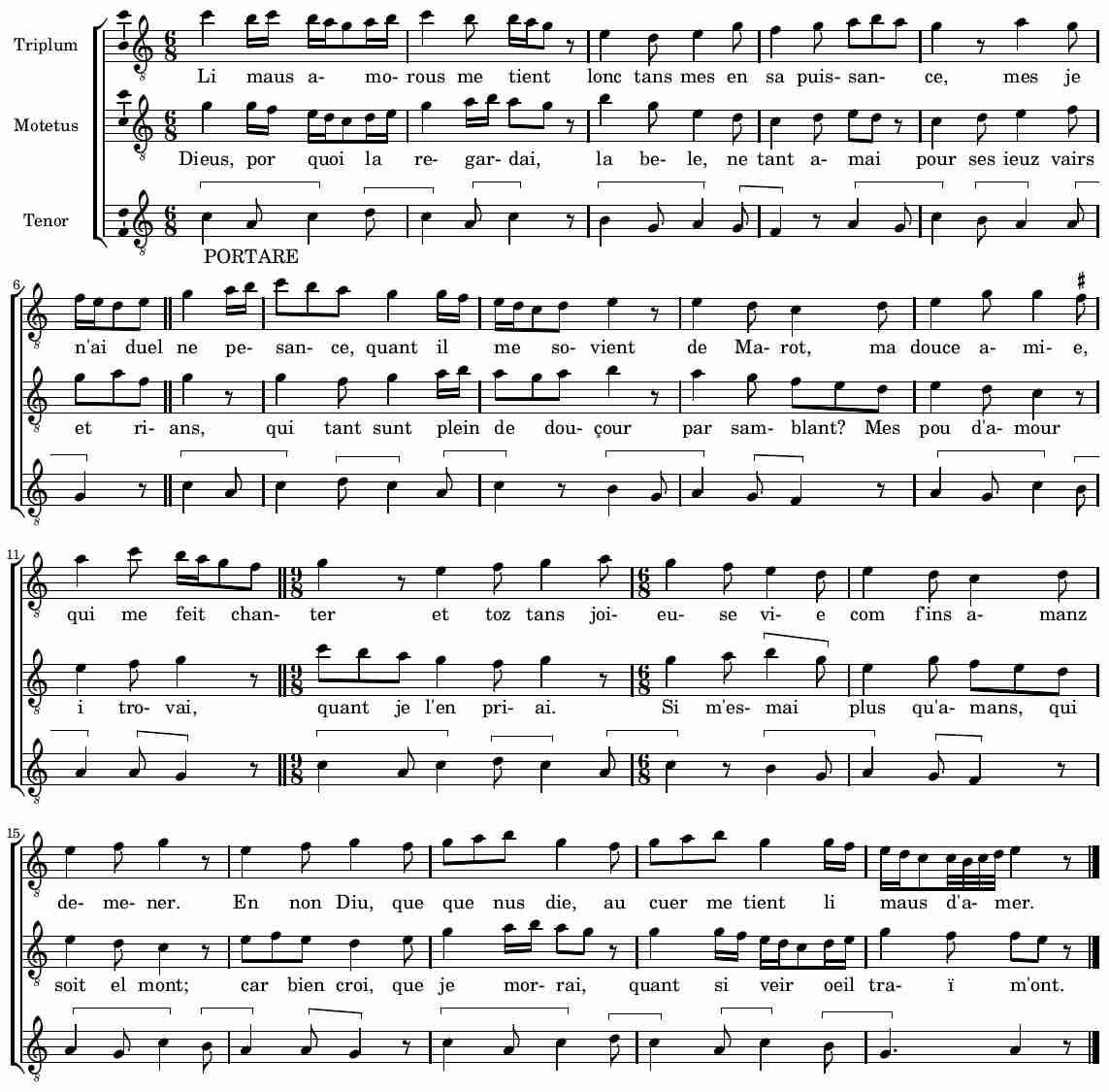
III.
A great variety of simple and complex isorhythmic constructions can be found in the Old Corpus. For example, the tenor of the first triple motet in fascicle two, MO 19 (Example 2), has a repeating rhythmic pattern of five pitches (with two rests), yet the first statement of the color, as marked by the 1978 A-R edition by Hans Tischler, is twenty-two pitches in length.22 These features are important to note, for the lack of a simple ratio between talea and color, in addition to the relatively brief length of the talea, would make MO 19 an archetypal "pre-isorhythmic" motet, according to the specifications offered by Hoppin.
Example 2
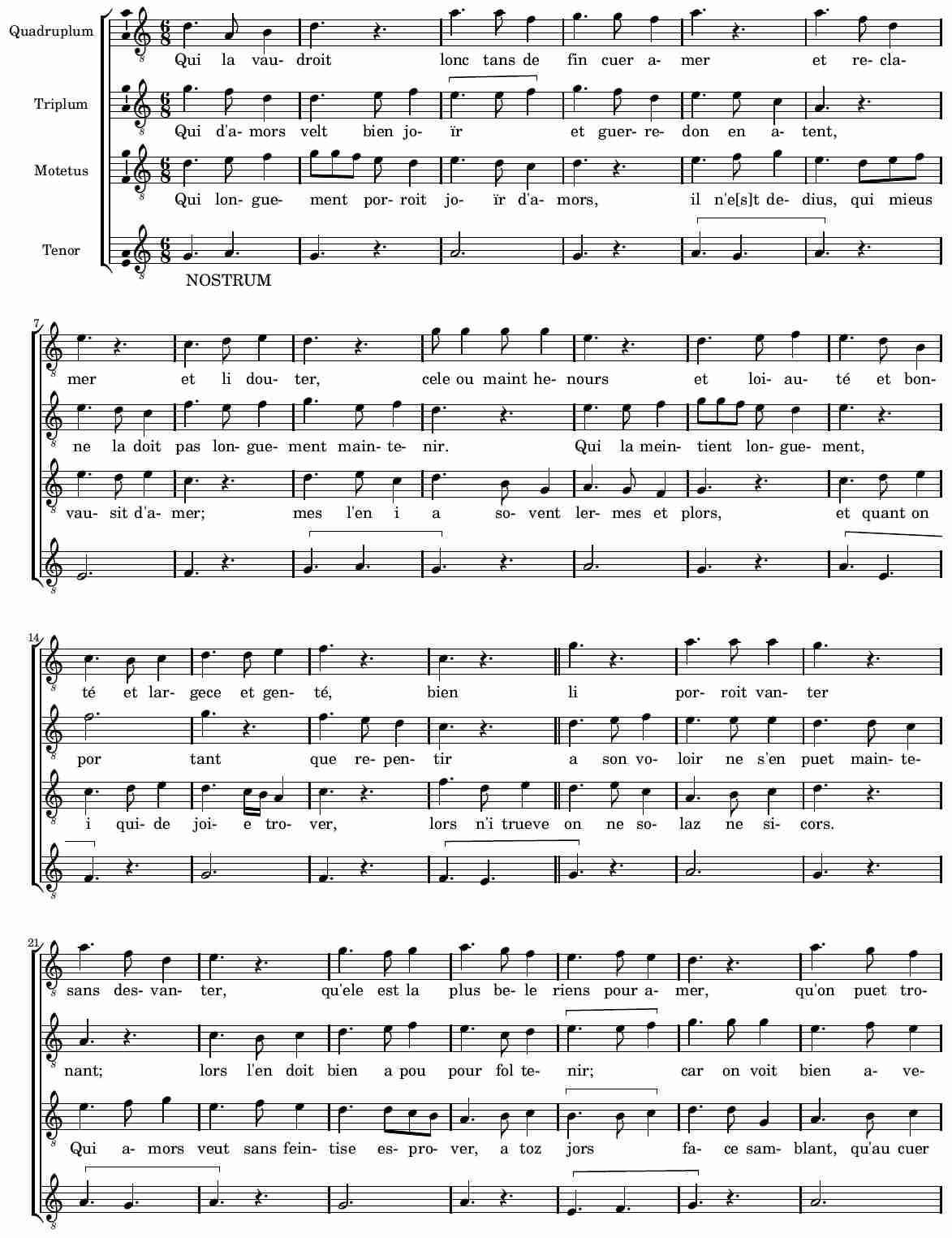

On the other hand, it could be argued that, through such mathematical dislocations between the color and the talea, the artifice of isorhythm is concealed to a greater degree than in motets in which a simple ratio is present. The pitch content in MO 19 from measures 18 to 34 is precisely the same as in measures 1 through 16, yet the staggered rhythmic content of the tenor conveys the impression of variety. Therefore, it might be more appropriate to describe measure 17 as transitional material, perhaps even as proof of foresight by the composer. Since there are only two repetitions of the color, the composer of MO 19 had to be willing to modify deliberate rhythmic patterns to suit more pressing musical needs at the close of the piece. In measure 33, the established rhythmic sequence could have been maintained by another three pitch melisma, with a single repetition of G allowing for a smooth cadence. Instead, the finality of the ending cadence is strengthened by a single long (interpreted as a dotted-half note by Tischler) which is held while the upper voices move in contrary motion.
It should be noted that MO 19 is not an isolated example of color / talea dislocation. Seven of the motets from fascicle three have tenors in which the color is indivisible by the talea, and more than a few have surprisingly complex pitch ratios. MO 64, for instance, combines a twenty-pitch color with a nine-pitch talea, and MO 113 combines a seventeen-pitch color with a six-pitch talea.
IV.
Partial, or incomplete, statements of the talea have been mentioned in reference to MO 19 and MO 96. Usually, they occur at the beginning or end of motets. However, composers of the early thirteenth-century motets in the Montpellier Codex were also apparently experimenting with partial rhythmic repetitions within extended taleae. In MO 34 (Example 3) there are three full expressions of a twenty-four pitch color, followed by an incomplete nine-pitch collection which closes the piece. The composer of MO 34 chose not to base the talea on a simple three, four, or eight-pitch repetition that would make for a simple color/talea ratio. Rather, the talea is initially based upon two nine-pitch rhythmic repetitions lasting twelve perfections, containing the widest possible array of rhythms available to a composer in the pre-Franconian era. Then, a six-note rhythmic subset of the initial nine-pitch rhythmic repetition completes the color, and the process restarts. (The rhythmic repetitions in the motet can also be expressed with the formula: 9+9+6, 9+9+6, 9+9+6, 9). Meticulous organization is quite evident in this motet, for the nine-pitch incomplete ending has a ready-made talea based on the initial rhythms and pitches of the piece. Thus, closure is achieved, and rhythmic variety within each color is fused with formal symmetry in an inventive transformation of the isorhythmic process.
Example 3
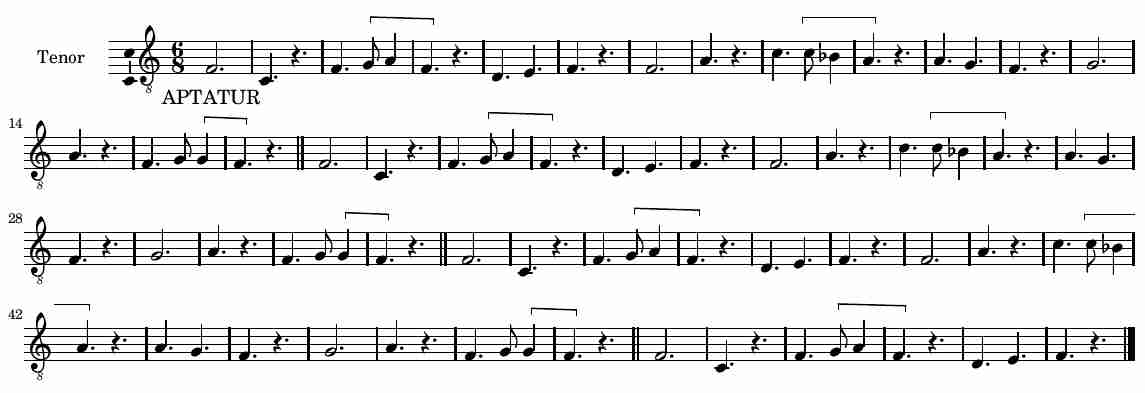
Instances where elongated colores are divided into several, relatively brief, taleae are, of course, abundant in fascicles two through five. Thirty-seven motets have taleae of exactly five pitches, and ninety-five taleae have five pitches or less. This still leaves, however, fifty-three rhythmic repetitions which are of reasonable length, utilize a multiplicity of patterns, and are not solely "expanded forms of the repeated rhythmic patterns in the tenors of clausulae and thirteenth-century motets."23
A few tenors even alternate between rhythmic modes within the talea. One notable example is MO 40, which has an eight-pitch talea that cycles between rhythmic modes one and five. Concerning the upper voices of MO 40, Mathiassen has noted that the "declamation involves a subdivision of the brevis into both three and four semibreves, and accordingly the modal character is almost completely effaced." Hence, the singular nature of the metric subdivisions in the upper voices is mirrored by a mixture of rhythmic modes in the tenor.
V.
As can be seen from the above examples, considerations of large-scale structure and form seem to have occupied the minds of early thirteenth-century motet composers, particularly when determining the exact number of rhythmic repetitions for the tenor. Nevertheless, tenor experimentation in the "Old Corpus" motets extends beyond color/talea ratios, displacement between the color and talea, partial repetitions of taleae, and variety in the length of rhythmic repetitions. A few double and triple motets in fascicles two through five have more than one color or talea. These provocative motets exhibit different approaches to the opportunities offered by a tenor divided by sections of contrasting musical material.
The tenors in MO 104 and MO 130 have two different colores; MO 104 (Example 4), in particular, warrants further consideration. The first color is nineteen pitches in length, yet the rhythmic repetitions are in groups of three pitches based upon rhythmic mode one. Ergo, the rhythmic values of pitches after the first statement of the color are altered, and the second statement of the first color is concealed when it arrives in measure seven.
Example 4
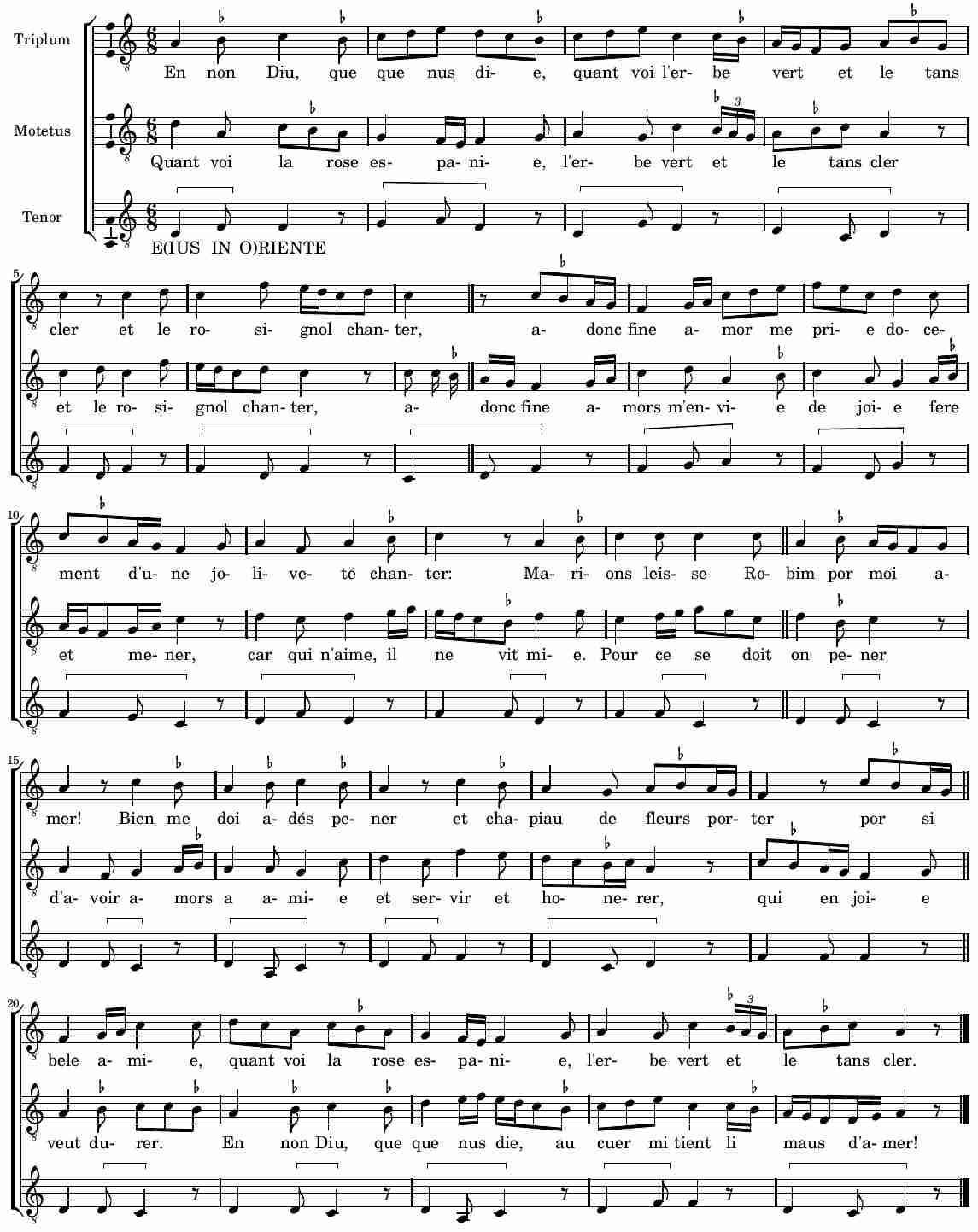
When the second color of MO 104 begins in measure fourteen, it continues for eighteen pitches, instead of nineteen. As a result, the persistent three-note talea does not alter the rhythmic profile of the second color when it returns for its second statement in measure twenty. Nevertheless, there is a significant difference between the two statements of the second color as the second statement includes only the first fifteen pitches of the first statement. Tischler marks the end of the color in measure nineteen, after the repeated F's in the tenor.24
This raises an interesting question. What if measure nineteen is simply a transitional measure, and the second color is meant to be interpreted as a fifteen pitch entity? Conspicuously, the upper voices engage in imitation from measure nineteen through the downbeat of measure twenty, with the triplum following the motetus in a descent from C5 to F4. The transitional aspect of this measure is accentuated by the fact that the same imitative gesture appears in both upper parts during measure seven, when the first color repeats.25
In eight motets from fascicles two through five, more than one form of the talea can be found.26 MO 53 begins with a simple three-pitch pattern in rhythmic mode five animated by a forty-eight note color (Example 5). Once the color completes its cycle and the talea has run through sixteen rhythmic repetitions, the talea changes to rhythmic mode one. Remarkably, the tenor part in MO 53 retains, for the most part, its original melodic contour. However, it does not merely rehash pitches from the first half of the piece to coincide with the change to rhythmic mode one. There are added pitches within the new five-pitch talea, and some degree of deviation is allowed so that cadences can continue to coincide with the last pitch of each talea. Consequently, the tenor part from measure thirty-three to sixty-four is more of a variation of the first thirty-two measures, rather than a strict repetition.
Example 5
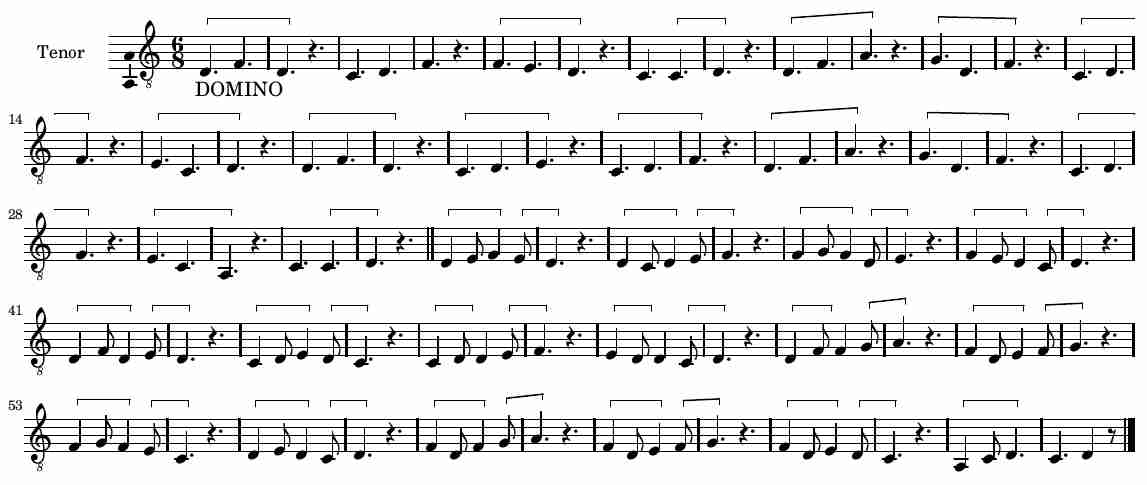
VI.
While it is true that early thirteenth-century motet composers did not change the mensurations of rhythmic repetitions in the tenor, these examples evince a willingness to utilize available rhythmic tools in an effort to achieve unconventional effects. The tenors of early thirteenth-century motets may not be originally composed, but they are subject to similar compositional processes and procedures as the tenors of the ars nova. Sustained melodies are divided into several taleae, a variety of simple and complex ratios between the color and the talae are evident, and compound forms are generated in motets when multiple colors and/or taleae are present. Additionally, it could be argued that thirteenth-century motets, as shown by the analyses of MO 104 and MO 53, occasionally disclose an inclination on the part of the composer to modify compositional techniques and structures when literary or structural concerns take precedence. The only defined feature of isorhythm that has not been considered thus far is diminution, a rhythmic technique that numerous writers on the Medieval motet solely attribute to motets from the fourteenth century.
For this reason, the most fascinating tenor from a motet in the "Old Corpus" might be found in MO 124. The color of MO 124 contains twenty-four pitches and is fully expressed three times, with five additional pitches at the end of the piece (Example 6). The first statement of the color is in rhythmic mode five, the second statement is in rhythmic mode one, and the final statement is in the rarely utilized rhythmic mode six.27 Since the rhythmic values are first shortened from ternary longs to a combination of longs and breves, and then to a continuous series of breves with each repetition of the color, the metric effect cleverly simulates diminution. Rhythmic and notational innovations facilitating the use of augmentation and diminution did not appear until the beginning of the fourteenth century, but this motet shows that composers in the thirteenth century were at least considering the formal implications of lengthening and shortening of rhythmic values in relation to the talea and color. This manipulation of the tenor is all the more tantalizing due to the relatively bland eighth-note patter declamation in the triplum and the lack of motivic variety in the motetus.
Example 6
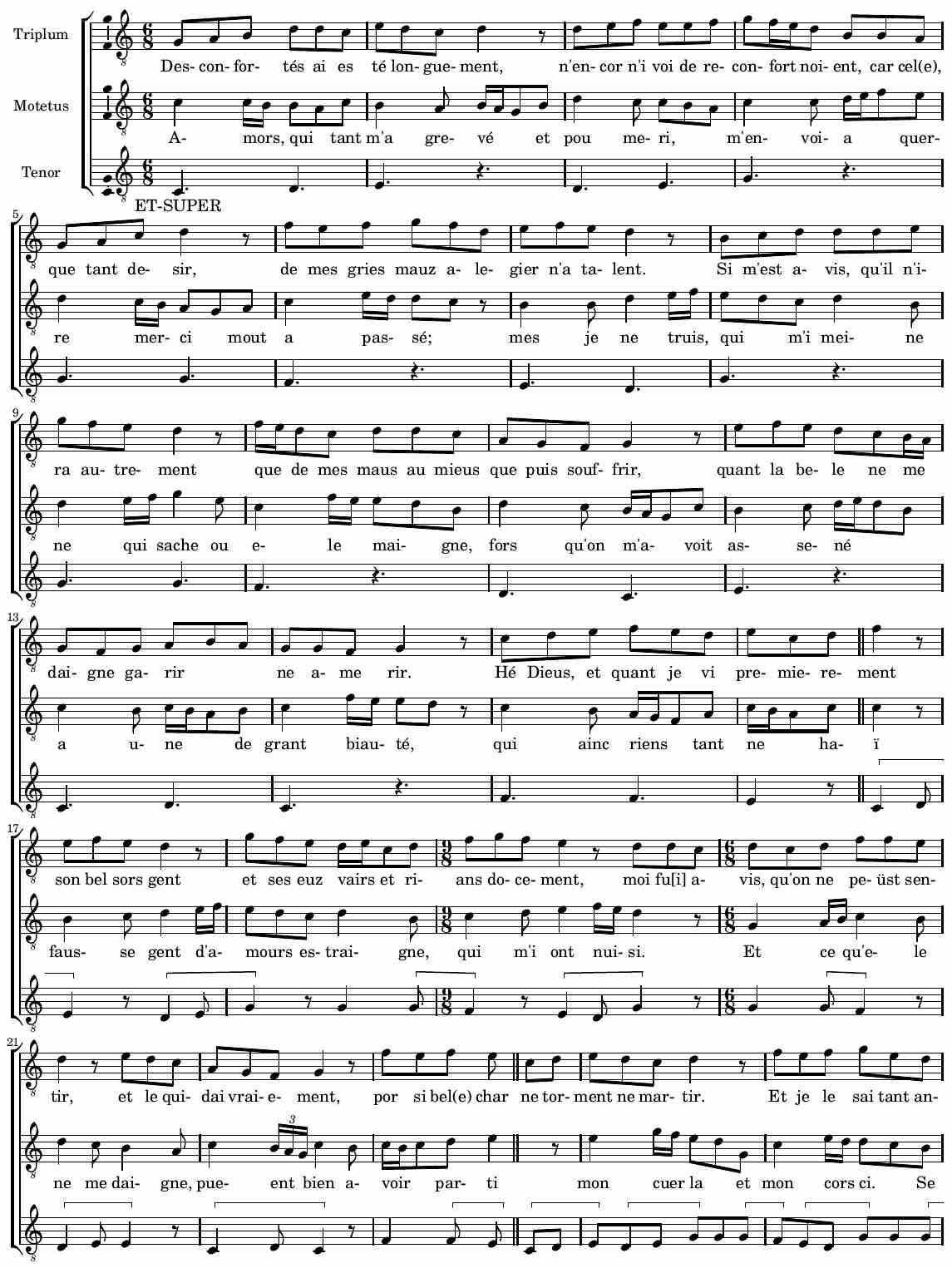

This essay has identified characteristics of tenors from early thirteenth-century motets from the Montpellier Codex that complicate the artificially fabricated, intransigent division between the ars antiqua and the ars nova. Each of Hoppin's "three isorhythmic procedures" which inform "future developments of the form" can be found in select tenors from the Old Corpus, often in ways that demonstrate resourceful approaches to managing the rhythmic modes. Moreover, the application of rhythmic and melodic repetitions in thirteenth-century motets is certainly more than "occasional." Even though rhythmic and melodic repetitions appear only in the tenor, there is evidence that the interplay between the isorhythmic tenor parts and the upper voices in "Old Corpus" motets was crafted with considerable deliberation.
It is important to be mindful of the differences in notation, rhythmic theories, and aesthetic values between the thirteenth and fourteenth centuries. Yet, there is an incongruity between the ubiquitous use of "isorhythm" to describe twentieth-century works which have repeating melodic and rhythmic ideas in a single voice, and the hesitancy by scholars to use "isorhythm" to describe many of the same features found in thirteenth-century music. Margaret Bent has invited critical response to this issue by writing that "as a descriptive term of limited application, isorhythm is unproblematic; but as an overall validating name for a genre, it is ripe for reconsideration."28 If isorhythm has indeed become a "validating" term, and, as a result, thirteenth-century motets are often viewed as predecessors of a more illustrious, "elite music"29 which flowered in the fourteenth century, reassessment may be necessary. The continued designation of thirteenth-century motets, such as those found in the "Old Corpus" of the Montpellier Codex, as "pre-isorhythmic" inadequately describes the evolution of an influential compositional technique and negatively stigmatizes a musically sophisticated and historically significant genre.
Bibliography
Bent, Margaret. "Isorhythm." In The New Grove Dictionary of Music and Musicians, 2nd ed. (accessed November 4, 2009).
________. "The Late-Medieval Motet." In Companion to Medieval and Renaissance Music, edited by Tess Knighton and David Fallows, 114-119. New York: Oxford University Press, 1997.
Burkholder, J. Peter, Donald J. Grout, and Claude V. Palisca, A History of Western Music, 8th ed. New York: W.W. Norton, 2010.
Everist, Mark. French Motets in the Thirteenth Century: Music, Poetry, and Genre. New York: Cambridge University Press, 1994.
Grout, Donald J. and Claude V. Palisca, A History of Western Music, 6th ed. New York: W.W. Norton, 2001.
Günther, Ursula. "The 14th-Century Motet and Its Development." In Musica Disciplina 12 (1958): 27-58.
Hoppin, Richard H. Medieval Music. New York: W.W. Norton, 1978.
Mathiassen, Finn. The Style of the Early Motet. Copenhagen: Dan Fog Musikforlang, 1966.
Randel, Don Michael, ed. Harvard Dictionary of Music. Cambridge: Belknap Press, 2003.
Sanders, Ernest. "The Medieval Motet." In Gattungen der Musik in Einzeldarstellungen: Gedenkschrift Leo Schrade, edited by Wulf Arlt, et al., 497‒573. Bern: Francke Verlag, 1973.
Taruskin, Richard. The Oxford History of Western Music, Vol. 1. New York: Oxford University Press, 2005.
Tischler, Hans, ed. The Montpellier Codex. Vol. 1 and 2. Madison: A-R Editions, 1978.
Notes
1For instance, at the outset of its entry on isorhythm, the fourth edition of the Harvard Dictionary of Music states that "[isorhythm] is found in motets of the fourteenth- and fifteenth-centuries." It is only mentioned several sentences later that "the repetition of both rhythmic and melodic patterns has precedents in the tenors of thirteenth-century motets." See Randel, ed., Harvard Dictionary of Music, 4th ed., 423.
Also, the sixth edition of A History of Western Music argues that "[Philippe] de Vitry's motet tenors provide the earliest examples of a unifying device called isorhythm." See Grout and Palisca, Western Music, 6th ed., 99. The most recent edition (2010) offers a refinement, stating that Vitry "extends the practice we observed in Notre Dame clausulae and thirteenth-century motets, where the tenor often repeats a rhythmic pattern and may also repeat a segment of melody." See Burkholder, Grout, and Palisca, Western Music, 8th ed., 117.
2Bent, "Isorhythm."
3See Taruskin, Western Music, Vol. 1, 266, and Bent, "Isorhythm."
4Bent, "Isorhythm." Also see Günther, "The 14th-Century Motet and Its Development," 27-58, and Sanders, "The Medieval Motet," 497‒573.
5Serialist composers such as Anton Webern and Milton Babbitt are most often mentioned, but the technique has also been used by twentieth-century composers as diverse as Olivier Messiaen and Peter Maxwell Davies.
6Mathiassen, Early Motet, 40.
7Ibid., 40.
8Ibid., 19. "In MO there is a sharp division between the Old Corpus of the manuscript, in which in fact quite embellished motets are to be found, but still within the limits of modal rhythm and the motets in the seventh and eighth fascicles."
9Hoppin, Medieval Music, 363.
10Ibid., 366.
11In her characterization of isorhythm, Bent states that "usually there are several taleae within a color. Sometimes melodic and rhythmic units are overlapped. . . Some motets present subsequent statements of the color in the same rhythm; others challenge an isorhythmic classification by presenting the repeats in mensural transformation and/or diminution." See Bent, "Isorhythm."
12Hoppin, Medieval Music, 363.
13Fascicle 1 is not included because it contains organa, hockets, and one conductus.
14I am influenced by Margaret Bent's petition that "marginalized, hybrid, minority and unusual pieces [should] return to centre-stage and challenge some of the traditional confining and tidy definitions." See Bent, "The Late-Medieval Motet," 118.
15In actuality, there are 159 numbered works in fascicles two through five. However, 11 either do not have music or are duplicated elsewhere in the Montpellier Codex. Also, I do not consider MO 68 to have a repeating color, even though Tischler marks it as such in his edition. Tischler, ed., The Montpellier Codex, II:61-62.
16There are six motets in fascicles two through four with more than two statements of the color: MO 24, 34, 37, 41, 70, and 72.
17The tenor in MO 24, for example, only has ten pitches in each cursus, which is the fewest in either fascicle two or three. However, it has six and a half repetitions of its color, making it the only tenor in fascicle two with more than three repetitions.
18For the sake of clarity, I often use the term "talea" to refer to rhythmic repetitions for the remainder of this paper.
19Twelve taleae in the Old Corpus have eight pitches or more.
20Since this is a "conductus motet," one could speculate that these flourishes simulate a cauda.
21The possibilities for a reading based upon numerology have been advanced by Mark Everist, who argued that "an interpretation of the motet cannot be established without a concept of number. From the simplest proportions of mensural notation to the most complicated numerical ground plan, number underpins much of the innovative, and a certain amount of the borrowed, in the motet." See Everist, French Motets in the Thirteenth Century, 8.
22Tischler, ed., The Montpellier Codex, I:36‒37.
23Hoppin, Medieval Music, 363.
24Tischler, ed., The Montpellier Codex, II:111.
25Also, the only other instance of repeated pitches (in rhythmic mode one) in the motet is in measure thirteen. The triplum repeats a C5 four times just before the beginning of the second color.
26These motets are MO 53, 76, 103, 116, 120, 124, 131, and 134.
27MO 134 also has a color that repeats twice and changes rhythmic modes from five to one. It does not continue to rhythmic mode six, though.
28Bent, "Isorhythm."
29This term is borrowed from Burkholder, et al., 113.


